
The Hispaniolan hutia is a small, endangered, rat-like mammal endemic to forests on the Caribbean island of Hispaniola. It lives in burrows or trees, and is active at night when it feeds on roots and fruits. A member of the hutia subfamily (Capromyinae), it is endangered from habitat loss and introduced species, such as rats or mongoose.

The Antillean palm swift is a species of bird in subfamily Apodinae of the swift family Apodidae. It is found on the Caribbean islands of Cuba, Jamaica, and Hispaniola.

The golden swallow is a swallow endemic to the Caribbean island of Hispaniola and was once native to Jamaica, but is now extirpated there. It is restricted to isolated montane forests that primarily consist of the Hispaniolan pine. This species is considered to be a vulnerable species by the International Union for Conservation of Nature (IUCN). The exact cause of its extirpation from Jamaica is unknown, but likely factors include predation by introduced mammals and habitat loss, although the habitat loss theory is not supported by much evidence. The last sighting of the nominate subspecies was in Hardwar Gap, with three birds being seen on 8 June 1989.

The tawny-faced quail is a species of bird in the family Odontophoridae, the New World quail. It is found in Colombia, Costa Rica, Ecuador, Honduras, Nicaragua, and Panama.

The least poorwill or least pauraque is a species of nightjar in the family Caprimulgidae, and the only confirmed extant species of its genus. It is endemic to the island of Hispaniola, which is shared by the Dominican Republic and Haiti.

The Hispaniolan lizard cuckoo is a species of bird in the tribe Phaenicophaeini, subfamily Cuculinae of the cuckoo family Cuculidae. It is endemic to the island of Hispaniola that is shared by Haiti and the Dominican Republic.
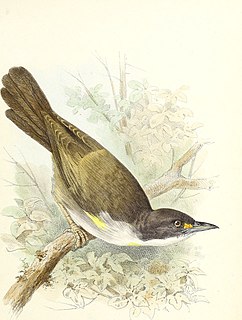
Calyptophilus is a genus of bird formerly placed in the family Thraupidae. The group was found to be distinct enough to be placed in its own family, Calyptophilidae. Established by Charles Barney Cory in 1884, it contains the following species:

The gray-barred wren is a species of bird in the family Troglodytidae. It is endemic to Mexico.

The green-tailed warbler, also known as the green-tailed ground-tanager, is a species of bird of the family Phaenicophilidae, the Hispaniolan tanagers. It is endemic to the island of Hispaniola which is shared by Haiti and the Dominican Republic.
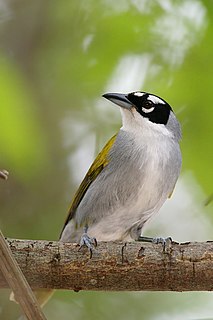
The black-crowned tanager or black-crowned palm-tanager is a species of bird of the family Phaenicophilidae, the Hispaniolan tanagers. It is endemic to the island of Hispaniola which is shared by Haiti and the Dominican Republic.
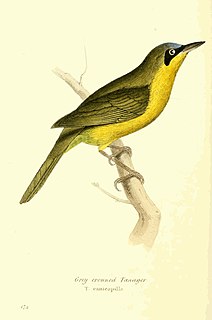
The grey-crowned tanager or grey-crowned palm-tanager is a Near Threatened species of bird in the family Phaenicophilidae, the Hispaniolan tanagers. It is endemic to the Caribbean island of Hispaniola, in both the Dominican Republic and Haiti.

The pilotbird is a species of passerine bird in the family Acanthizidae. It is monotypic within the genus Pycnoptilus. The species is endemic to south-eastern Australia.
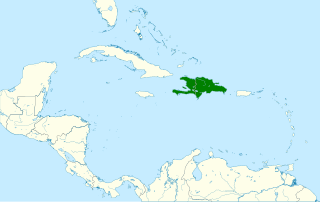
The Hispaniolan spindalis is one of four species of bird in family Spindalidae. It is endemic to the Caribbean island of Hispaniola which is shared by Haiti and the Dominican Republic.
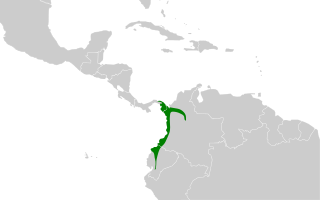
The stripe-throated wren is a species of bird in the family Troglodytidae. It is found in Colombia, Ecuador, and Panama.

The white-winged warbler, also called the white-winged ground-warbler, is a Vulnerable species of bird of the family Phaenicophilidae, the Hispaniolan tanagers. It is endemic to the island of Hispaniola which is shared by Haiti and the Dominican Republic.

The western chat-tanager is a Vulnerable species of passerine bird belonging to the family Calyptophilidae. It is endemic to the island of Hispaniola which is shared by the Dominican Republic and Haiti.

The Hispaniolan moist forests are a tropical moist broadleaf forest ecoregion on the island of Hispaniola. They cover 46,000 km2 (18,000 sq mi), around 60% of the island's area.




















